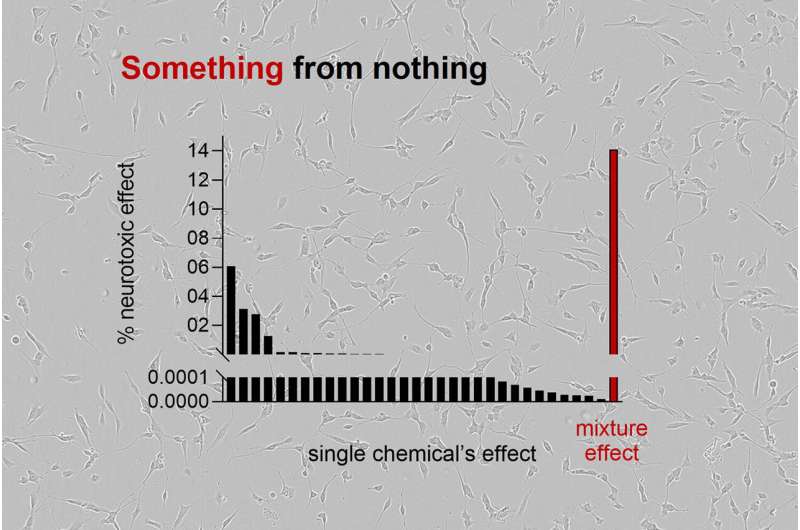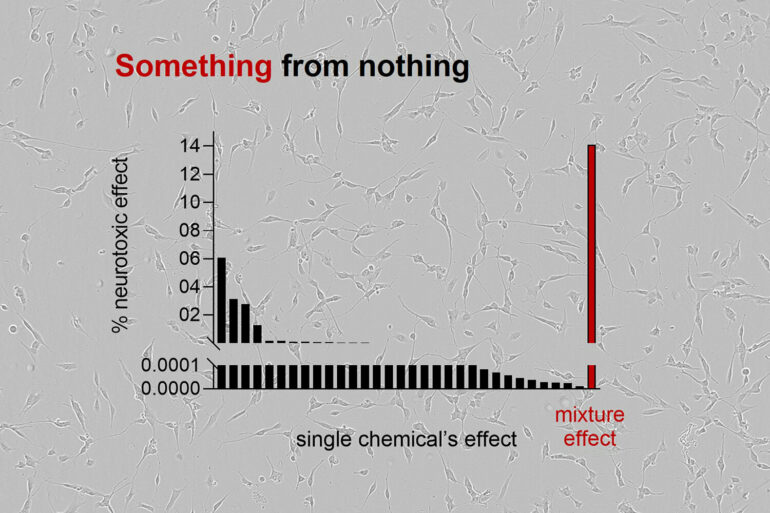Chemicals are omnipresent today. They enter our bodies through food, air or the skin. But how do these complex mixtures of chemicals affect our health? In a new study, a research team from the Helmholtz Centre for Environmental Research (UFZ) has shown that chemicals that occur in complex mixtures and in concentration ratios as found in humans act together.
Even if the concentrations of the individual substances were each below the effect threshold, the chemicals in the mixture showed a cumulative neurotoxic effect. For their investigations, they used blood samples from pregnant women from the LiNA mother-child study (lifestyle and environmental factors and their influence on the newborn allergy risk), which has been running at the UFZ since 2006.
The research is published in the journal Science.
“In our everyday lives, we are exposed to a wide variety of chemicals that are distributed and accumulate in our bodies. These are highly complex mixtures that can affect bodily functions and our health,” says Prof Beate Escher, Head of the UFZ Department of Cell Toxicology and Professor at the University of Tübingen.
“It is known from environmental and water studies that the effects of chemicals add up when they occur in low concentrations in complex mixtures. Whether this is also the case in the human body has not yet been sufficiently investigated—this is precisely where our study comes in.”
The extensive research work was based on over 600 blood samples from pregnant women from the Leipzig mother-child cohort LiNA, which has been coordinated by the UFZ since 2006. The researchers first analyzed the individual mixtures of chemicals present in these samples.
“We wanted to find out which chemicals were contained in the blood plasma and in what concentrations. We used a two-step extraction process to isolate as diverse chemical mixtures as possible,” says Georg Braun, postdoctoral researcher in Beate Escher’s working group and first author of the study.
“Using mass spectrometry analyses, we searched for 1,000 different chemicals that we knew could occur in the environment, could potentially be ingested by humans, and could be relevant for adverse human health effects. Of these, we were able to quantify around 300 chemicals in several plasma samples.”
This provided the researchers with information on the composition and concentration ratios of the chemical mixtures present in the 600 individual plasma samples.
The researchers used a prediction model to calculate the neurotoxic effects of the chemical mixtures. To test the predictions of the mixture effects experimentally, they used an established cellular bioassay based on human cells that indicates neurotoxic effects.
“We analyzed individual chemicals as well as around 80 different self-produced chemical mixtures in realistic concentration ratios. The extracts of the plasma samples were also tested,” says Braun. The results were clear.
“The laboratory experiments confirmed the predictions from the model: The effects of the chemicals add up in complex mixtures,” says environmental toxicologist Escher. “Even if the individual concentrations of neurotoxic chemicals are so low that they are each below the effect threshold, there is still an effect on nerve-like cells in complex mixtures with many other chemicals.”

Demonstration of the “something from nothing” phenomenon. The in majority low effects of the single chemicals that are found in one sample accumulate to measurable mixture effects. © UFZ
But what exactly do these results mean?
“With our study, we were able to prove for the first time that what is known about the effects of chemical mixtures in the environment also applies to humans,” says Escher. “It is therefore imperative that we rethink risk assessment. Indicator substances alone are far from sufficient. In future, we must learn to think in terms of mixtures.”
UFZ environmental immunologist and head of the LiNA study Dr. Gunda Herberth adds, “It is becoming increasingly clear that many diseases such as allergies, immune system disorders, obesity or the development of the nervous system are linked to exposure to chemicals in the womb or in early childhood.”
The test method presented in this study—the extraction of chemical mixtures from human samples and their characterization using chemical analysis combined with cell-based biotest systems—opens up new possibilities for researching the effects of complex chemical mixtures on human health.
In future research projects, the scientists want to refine their test method and investigate the effects of chemical mixtures on other health-relevant endpoints such as immunotoxicity. In addition, they would like to uncover possible links between chemical exposure and the development of developmental disorders in children.
As members of the German Centre for Child and Adolescent Health, a Germany-wide research network of university hospitals, universities and non-university research institutions, the UFZ researchers will work with numerous experts from the fields of medicine and epidemiology in the future in order to apply these methods of effect-based human biomonitoring in practice.
More information:
Georg Braun et al, Neurotoxic mixture effects of chemicals extracted from blood of pregnant women, Science (2024). DOI: 10.1126/science.adq0336. www.science.org/doi/10.1126/science.adq0336
Provided by
Helmholtz Association of German Research Centres
Citation:
Health effects of chemical mixtures: Neurotoxic effects add up, new study shows (2024, October 17)



